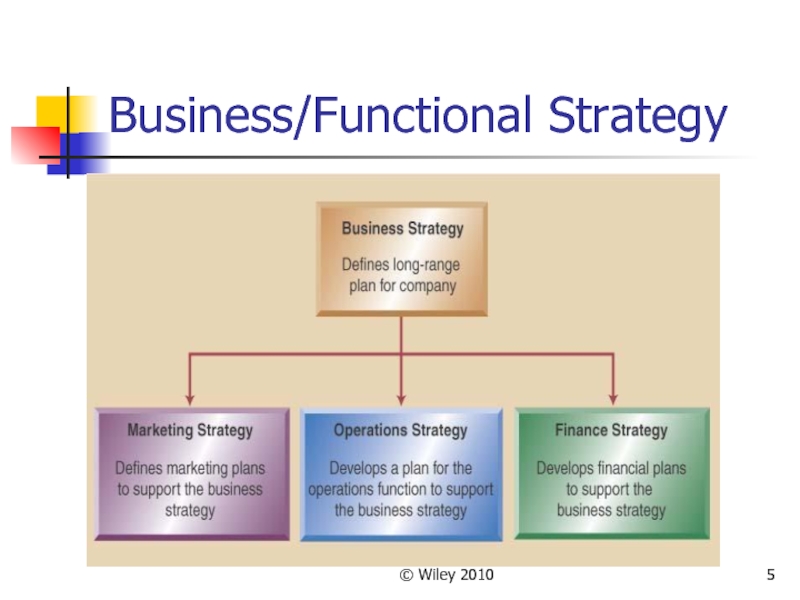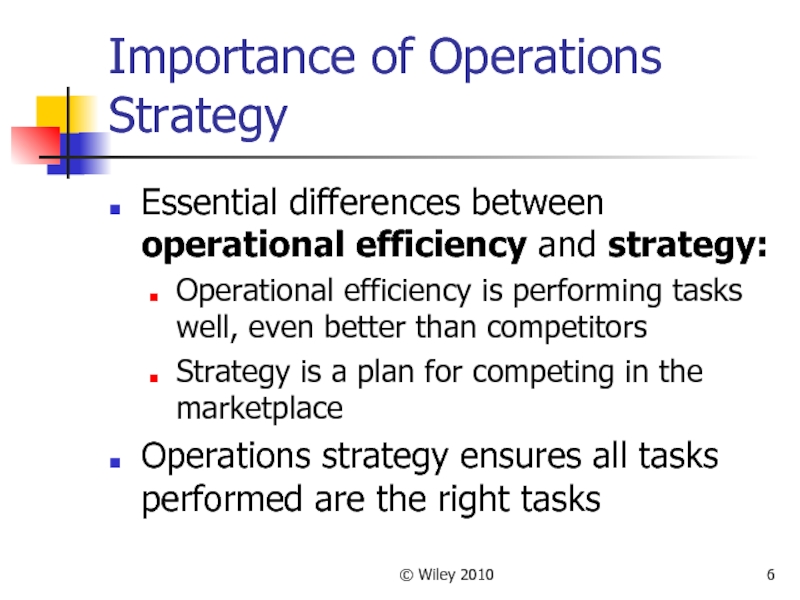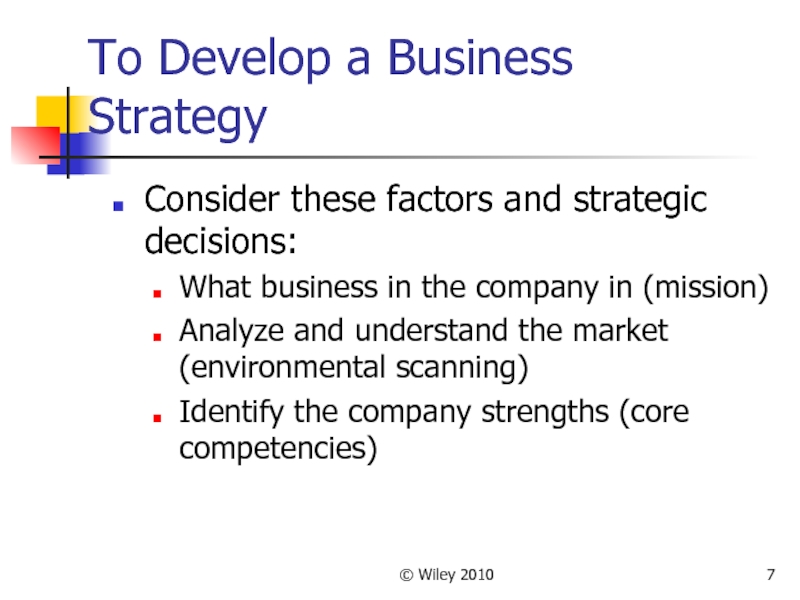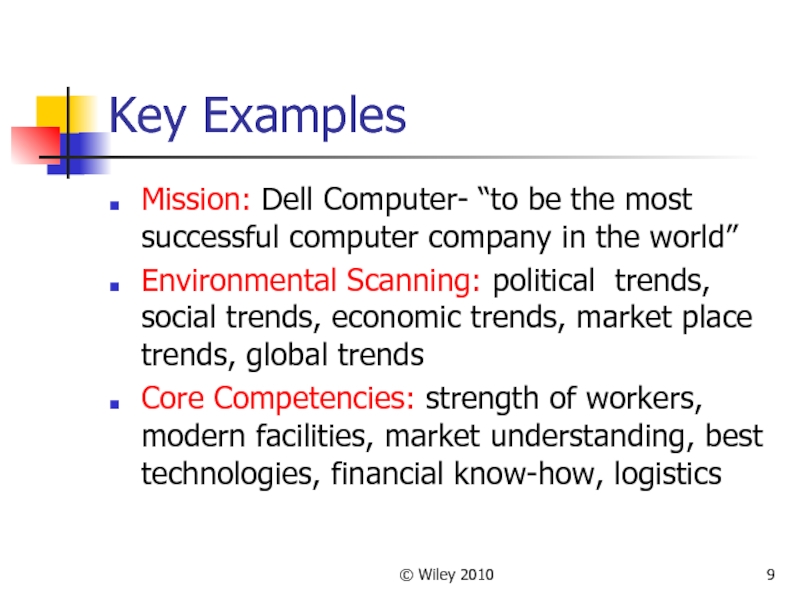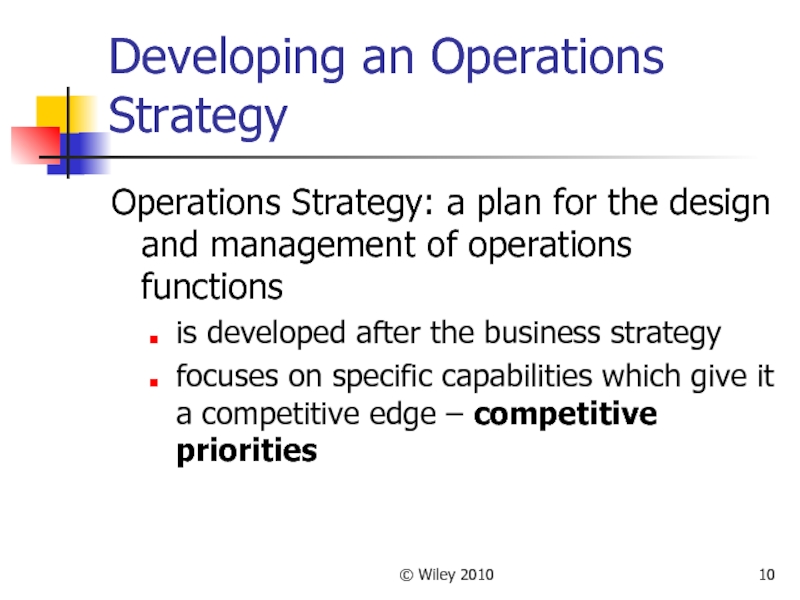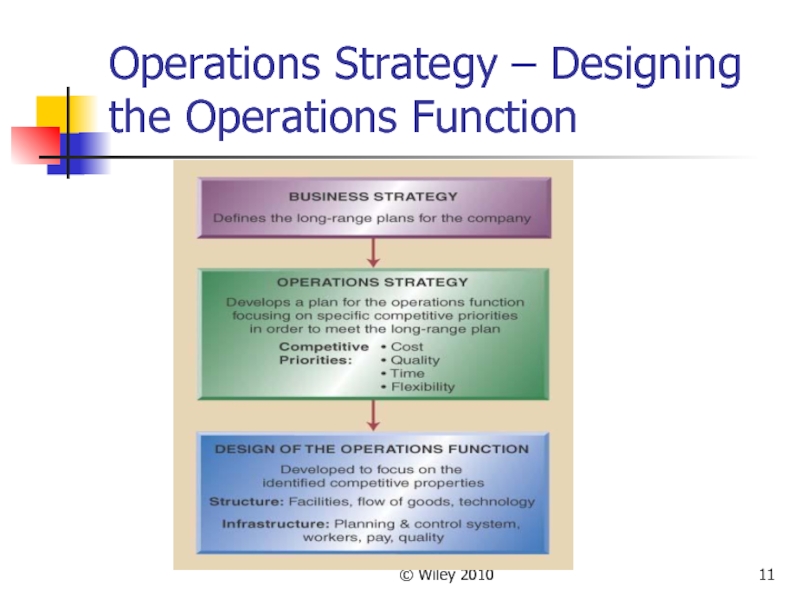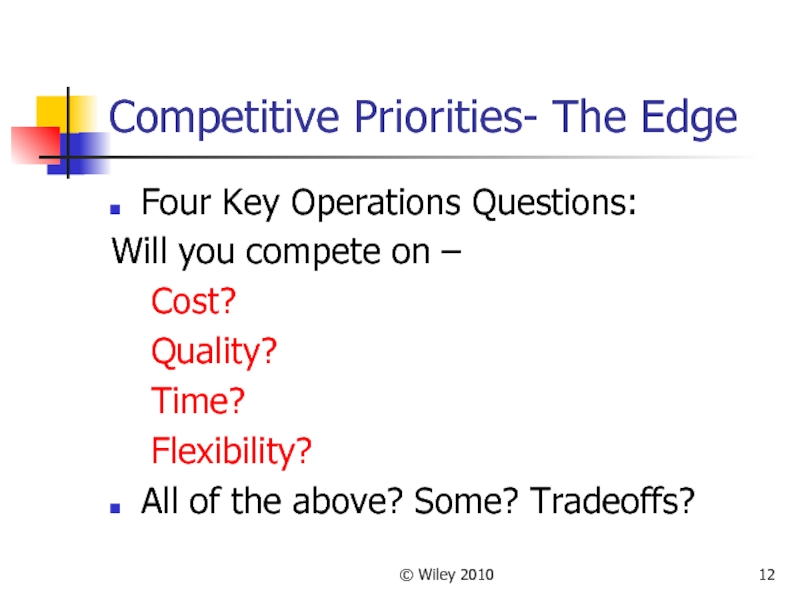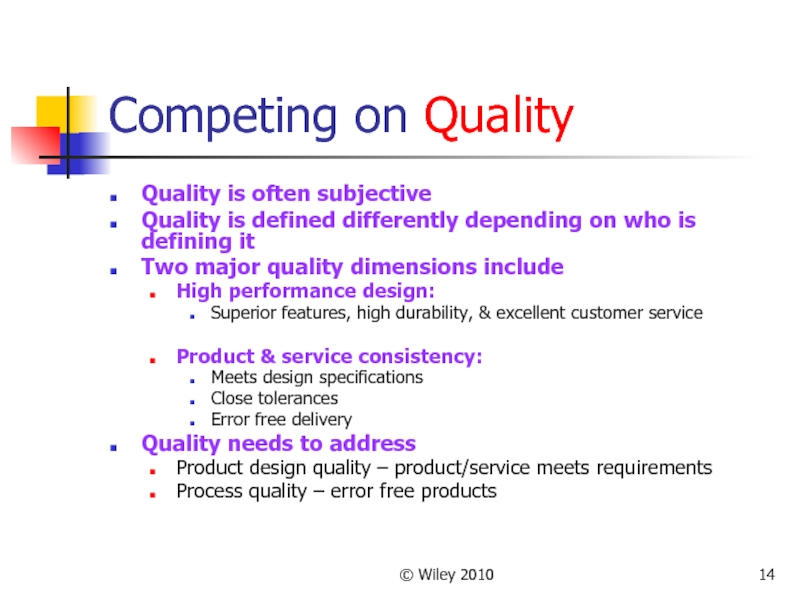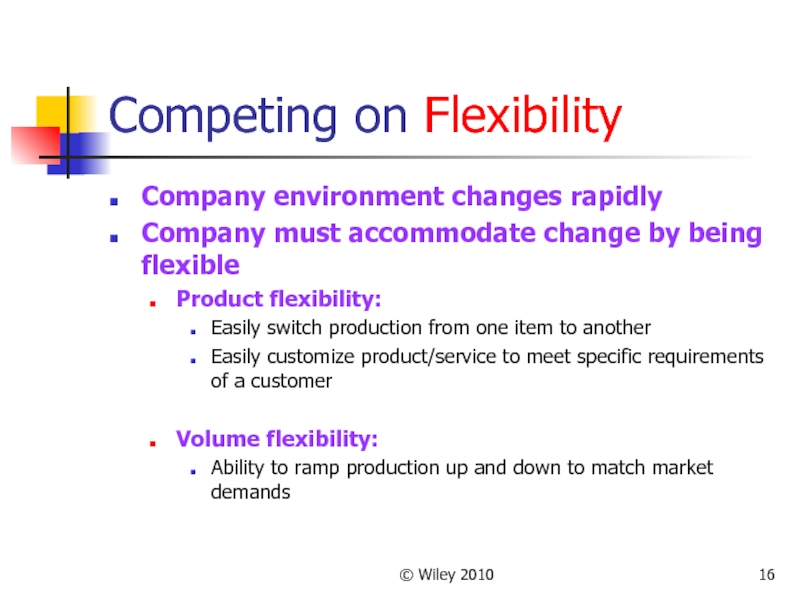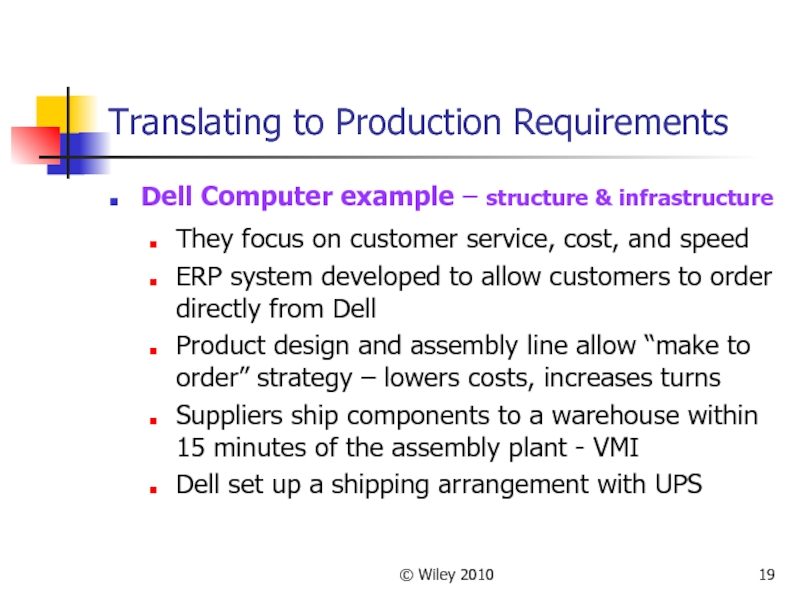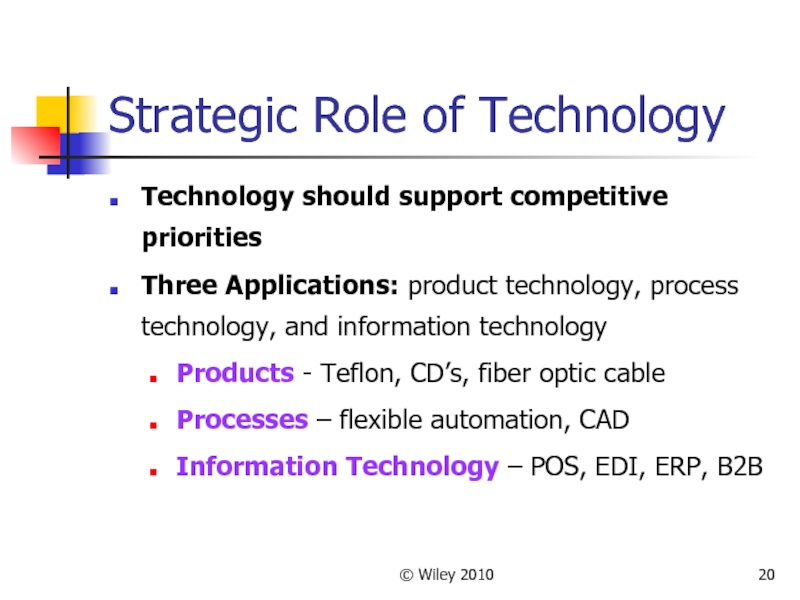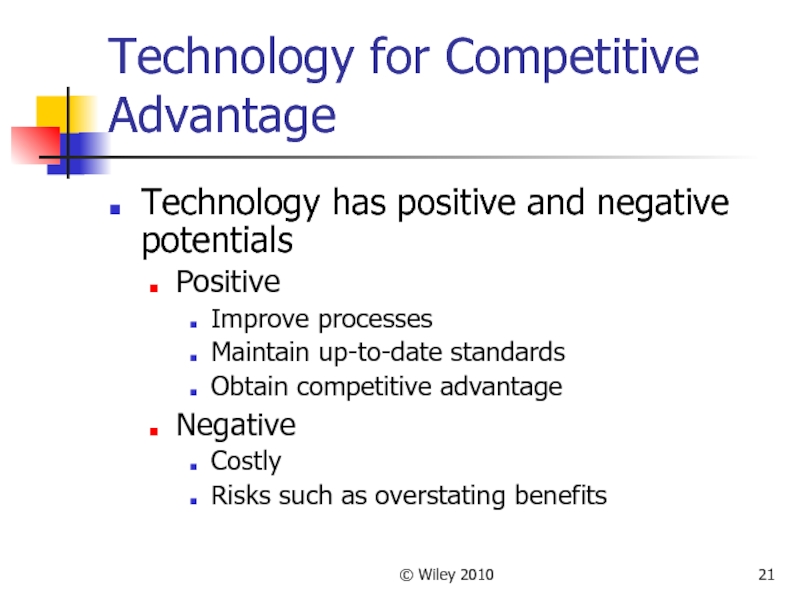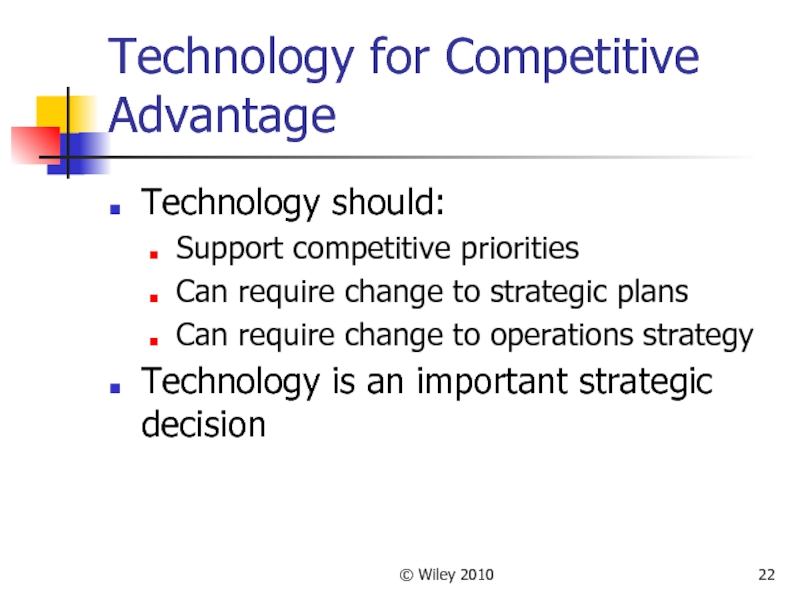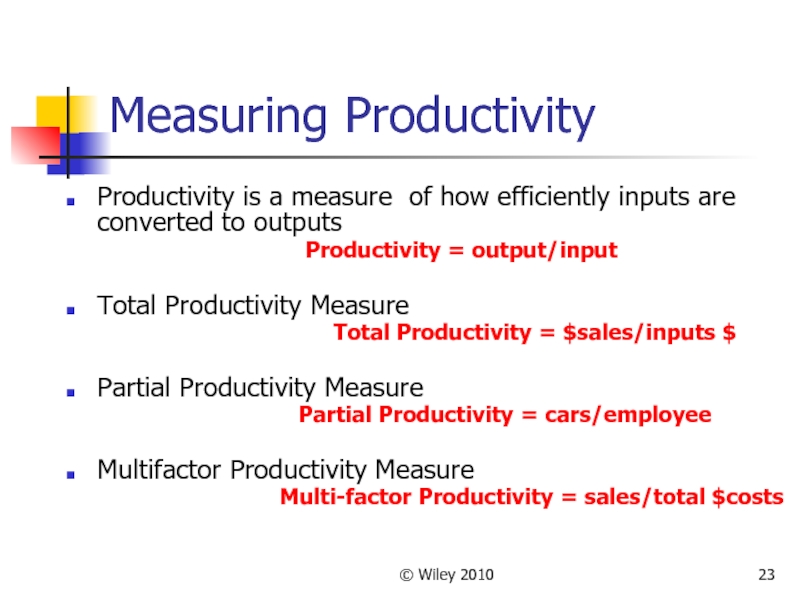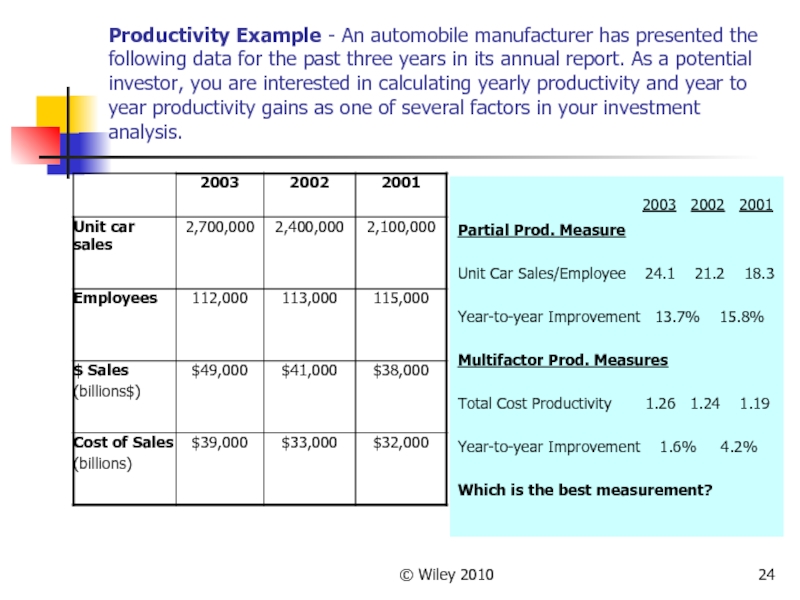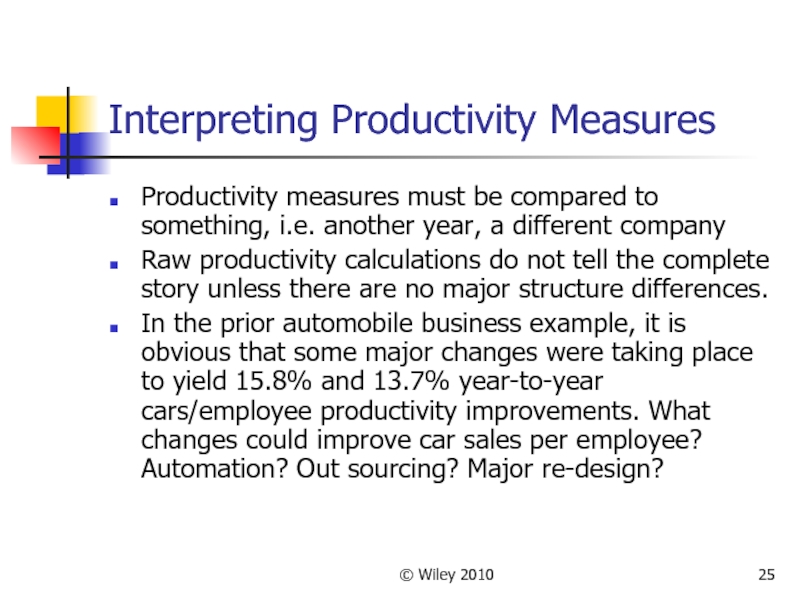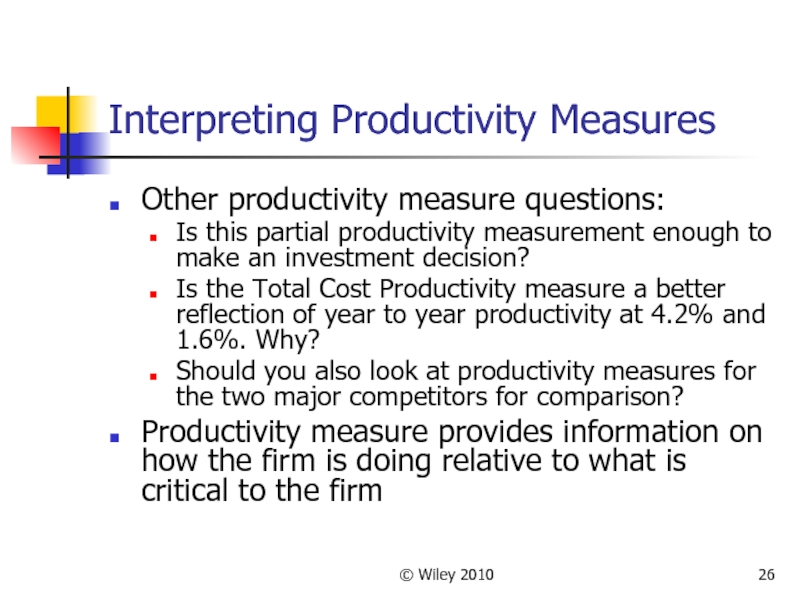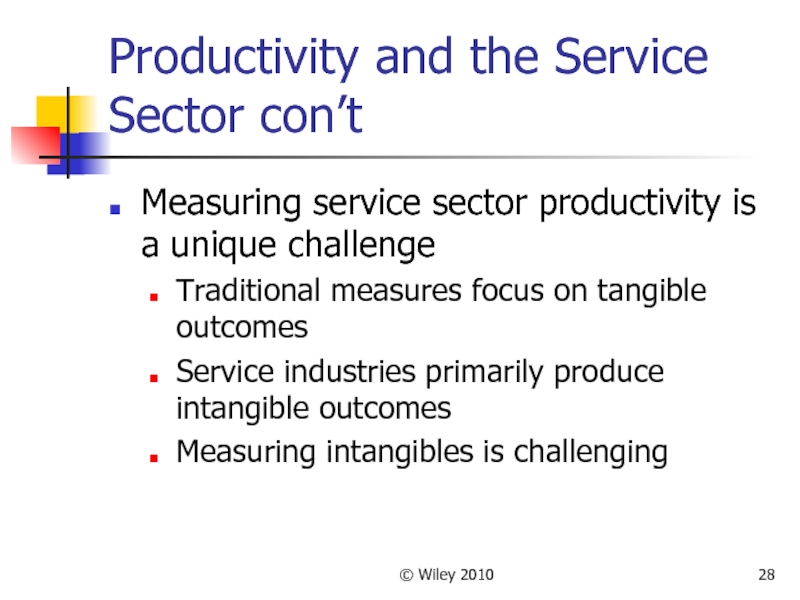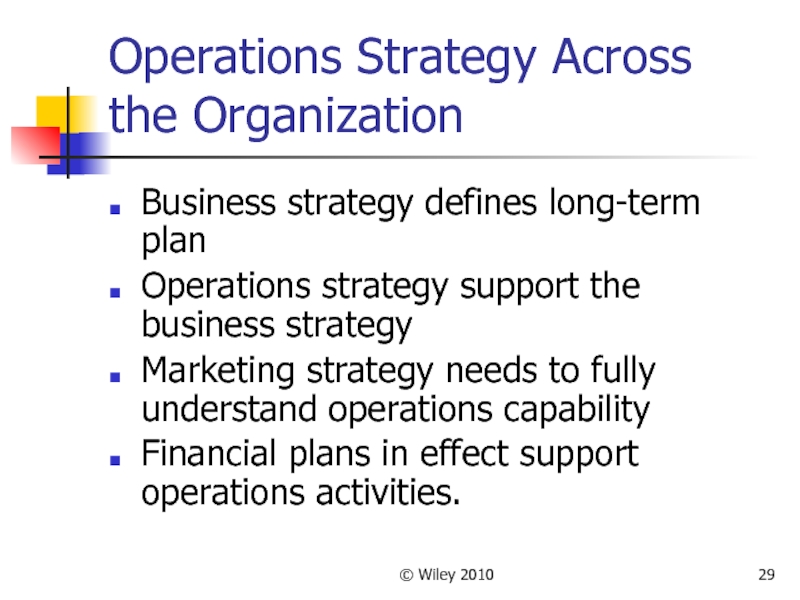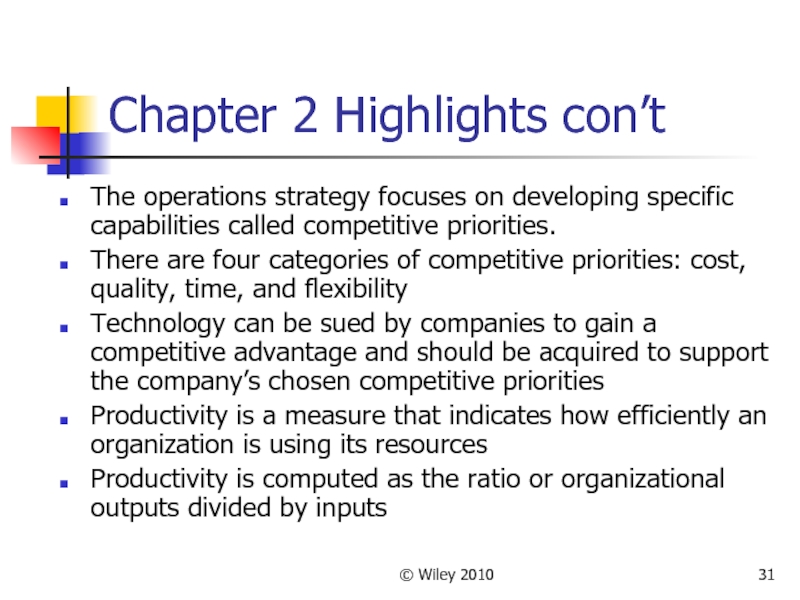- Главная
- Разное
- Дизайн
- Бизнес и предпринимательство
- Аналитика
- Образование
- Развлечения
- Красота и здоровье
- Финансы
- Государство
- Путешествия
- Спорт
- Недвижимость
- Армия
- Графика
- Культурология
- Еда и кулинария
- Лингвистика
- Английский язык
- Астрономия
- Алгебра
- Биология
- География
- Детские презентации
- Информатика
- История
- Литература
- Маркетинг
- Математика
- Медицина
- Менеджмент
- Музыка
- МХК
- Немецкий язык
- ОБЖ
- Обществознание
- Окружающий мир
- Педагогика
- Русский язык
- Технология
- Физика
- Философия
- Химия
- Шаблоны, картинки для презентаций
- Экология
- Экономика
- Юриспруденция
Operations strategy and competitiveness презентация
Содержание
- 1. Operations strategy and competitiveness
- 2. © Wiley 2010 Learning Objectives Define the
- 3. © Wiley 2010 Learning Objectives Identify competitive
- 4. © Wiley 2010 The Role of Operations
- 5. © Wiley 2010 Business/Functional Strategy
- 6. © Wiley 2010 Importance of Operations Strategy
- 7. © Wiley 2010 To Develop a Business
- 8. © Wiley 2010 Three Inputs to a Business Strategy
- 9. © Wiley 2010 Key Examples Mission:
- 10. © Wiley 2010 Developing an Operations Strategy
- 11. © Wiley 2010 Operations Strategy – Designing the Operations Function
- 12. © Wiley 2010 Competitive Priorities- The Edge
- 13. © Wiley 2010 Competing on Cost Offering
- 14. © Wiley 2010 Competing on Quality Quality
- 15. © Wiley 2010 Competing on Time Time/speed
- 16. © Wiley 2010 Competing on Flexibility Company
- 17. © Wiley 2010 The Need for Trade-offs
- 18. © Wiley 2010 Translating to Production Requirements
- 19. © Wiley 2010 Translating to Production Requirements
- 20. © Wiley 2010 Strategic Role of Technology
- 21. © Wiley 2010 Technology for Competitive Advantage
- 22. © Wiley 2010 Technology for Competitive Advantage
- 23. © Wiley 2010 Measuring Productivity Productivity is
- 24. © Wiley 2010 Productivity Example - An
- 25. © Wiley 2010 Interpreting Productivity Measures Productivity
- 26. © Wiley 2010 Interpreting Productivity Measures Other
- 27. © Wiley 2010 Productivity, Competitiveness, and the
- 28. © Wiley 2010 Productivity and the Service
- 29. © Wiley 2010 Operations Strategy Across the
- 30. © Wiley 2010 Chapter 2 Highlights Business
- 31. © Wiley 2010 Chapter 2 Highlights con’t
- 32. © Wiley 2010
Слайд 1© Wiley 2010
Chapter 2 - Operations Strategy and Competitiveness
Operations Management
by
R. Dan
4th Edition © Wiley 2010
Слайд 2© Wiley 2010
Learning Objectives
Define the role of Business Strategy
Explain how a
Explain the role of Operations Strategy in the organization
Explain the relationship between business strategy and operations strategy
Describe how an operations strategy is developed
Слайд 3© Wiley 2010
Learning Objectives
Identify competitive priorities for of the operations function
Explain
Define productivity and identify productivity measures
Compute productivity measures
Слайд 4© Wiley 2010
The Role of Operations Strategy
Provide a plan that makes
Specifies the policies and plans for using organizational resources
Supports Business Strategy as shown on next slide
Слайд 6© Wiley 2010
Importance of Operations Strategy
Essential differences between operational efficiency and
Operational efficiency is performing tasks well, even better than competitors
Strategy is a plan for competing in the marketplace
Operations strategy ensures all tasks performed are the right tasks
Слайд 7© Wiley 2010
To Develop a Business Strategy
Consider these factors and strategic
What business in the company in (mission)
Analyze and understand the market (environmental scanning)
Identify the company strengths (core competencies)
Слайд 9© Wiley 2010
Key Examples
Mission: Dell Computer- “to be the most
Environmental Scanning: political trends, social trends, economic trends, market place trends, global trends
Core Competencies: strength of workers, modern facilities, market understanding, best technologies, financial know-how, logistics
Слайд 10© Wiley 2010
Developing an Operations Strategy
Operations Strategy: a plan for the
is developed after the business strategy
focuses on specific capabilities which give it a competitive edge – competitive priorities
Слайд 12© Wiley 2010
Competitive Priorities- The Edge
Four Key Operations Questions:
Will you
Cost?
Quality?
Time?
Flexibility?
All of the above? Some? Tradeoffs?
Слайд 13© Wiley 2010
Competing on Cost
Offering product at a low price relative
Typically high volume products
Often limit product range & offer little customization
May invest in automation to reduce unit costs
Can use lower skill labor
Probably uses product focused layouts
Low cost does not mean low quality
Слайд 14© Wiley 2010
Competing on Quality
Quality is often subjective
Quality is defined differently
Two major quality dimensions include
High performance design:
Superior features, high durability, & excellent customer service
Product & service consistency:
Meets design specifications
Close tolerances
Error free delivery
Quality needs to address
Product design quality – product/service meets requirements
Process quality – error free products
Слайд 15© Wiley 2010
Competing on Time
Time/speed one of most important competition priorities
First
Time related issues involve
Rapid delivery:
Focused on shorter time between order placement and delivery
On-time delivery:
Deliver product exactly when needed every time
Слайд 16© Wiley 2010
Competing on Flexibility
Company environment changes rapidly
Company must accommodate change
Product flexibility:
Easily switch production from one item to another
Easily customize product/service to meet specific requirements of a customer
Volume flexibility:
Ability to ramp production up and down to match market demands
Слайд 17© Wiley 2010
The Need for Trade-offs
Decisions must emphasize priorities that support
Decisions often required trade offs
Decisions must focus on order qualifiers and order winners
Which priorities are “Order Qualifiers”?
Must have excellent quality since everyone expects it
Which priorities are “Order Winners”?
Dell competes on all four priorities
Southwest Airlines competes on cost
McDonald’s competes on consistency
FedEx competes on speed
Custom tailors compete on flexibility
Слайд 18© Wiley 2010
Translating to Production Requirements
Specific Operation requirements include two general
Structure – decisions related to the production process, such as characteristics of facilities used, selection of appropriate technology, and the flow of goods and services
Infrastructure – decisions related to planning and control systems of operations
Слайд 19© Wiley 2010
Translating to Production Requirements
Dell Computer example – structure &
They focus on customer service, cost, and speed
ERP system developed to allow customers to order directly from Dell
Product design and assembly line allow “make to order” strategy – lowers costs, increases turns
Suppliers ship components to a warehouse within 15 minutes of the assembly plant - VMI
Dell set up a shipping arrangement with UPS
Слайд 20© Wiley 2010
Strategic Role of Technology
Technology should support competitive priorities
Three Applications:
Products - Teflon, CD’s, fiber optic cable
Processes – flexible automation, CAD
Information Technology – POS, EDI, ERP, B2B
Слайд 21© Wiley 2010
Technology for Competitive Advantage
Technology has positive and negative potentials
Positive
Improve
Maintain up-to-date standards
Obtain competitive advantage
Negative
Costly
Risks such as overstating benefits
Слайд 22© Wiley 2010
Technology for Competitive Advantage
Technology should:
Support competitive priorities
Can require change
Can require change to operations strategy
Technology is an important strategic decision
Слайд 23© Wiley 2010
Measuring Productivity
Productivity is a measure of how efficiently inputs
Productivity = output/input
Total Productivity Measure
Total Productivity = $sales/inputs $
Partial Productivity Measure
Partial Productivity = cars/employee
Multifactor Productivity Measure
Multi-factor Productivity = sales/total $costs
Слайд 24© Wiley 2010
Productivity Example - An automobile manufacturer has presented the
2003 2002 2001
Partial Prod. Measure
Unit Car Sales/Employee 24.1 21.2 18.3
Year-to-year Improvement 13.7% 15.8%
Multifactor Prod. Measures
Total Cost Productivity 1.26 1.24 1.19
Year-to-year Improvement 1.6% 4.2%
Which is the best measurement?
Слайд 25© Wiley 2010
Interpreting Productivity Measures
Productivity measures must be compared to something,
Raw productivity calculations do not tell the complete story unless there are no major structure differences.
In the prior automobile business example, it is obvious that some major changes were taking place to yield 15.8% and 13.7% year-to-year cars/employee productivity improvements. What changes could improve car sales per employee? Automation? Out sourcing? Major re-design?
Слайд 26© Wiley 2010
Interpreting Productivity Measures
Other productivity measure questions:
Is this partial
Is the Total Cost Productivity measure a better reflection of year to year productivity at 4.2% and 1.6%. Why?
Should you also look at productivity measures for the two major competitors for comparison?
Productivity measure provides information on how the firm is doing relative to what is critical to the firm
Слайд 27© Wiley 2010
Productivity, Competitiveness, and the Service Sector
Productivity is a scorecard
A nation’s Productivity effects its standard of living
US productivity growth averaged 2.8% from
1948-1973
Productivity growth slowed for the next 25 years to 1.1%
Productivity growth in service industries has been less than in manufacturing
Слайд 28© Wiley 2010
Productivity and the Service Sector con’t
Measuring service sector productivity
Traditional measures focus on tangible outcomes
Service industries primarily produce intangible outcomes
Measuring intangibles is challenging
Слайд 29© Wiley 2010
Operations Strategy Across the Organization
Business strategy defines long-term plan
Operations
Marketing strategy needs to fully understand operations capability
Financial plans in effect support operations activities.
Слайд 30© Wiley 2010
Chapter 2 Highlights
Business Strategy is a long range plan
An organization develops its business strategy by doing environmental scanning and considering its mission and its core competencies.
The role of operations strategy is to provide a long-range plan for the use of the company’s resources in producing the company’s primary goods and services.
The role of business strategy is to serve as an overall guide for the development of the organization’s operations strategy.
Слайд 31© Wiley 2010
Chapter 2 Highlights con’t
The operations strategy focuses on developing
There are four categories of competitive priorities: cost, quality, time, and flexibility
Technology can be sued by companies to gain a competitive advantage and should be acquired to support the company’s chosen competitive priorities
Productivity is a measure that indicates how efficiently an organization is using its resources
Productivity is computed as the ratio or organizational outputs divided by inputs




